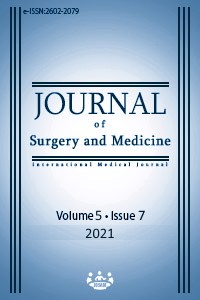Evaluation of changes in corneal endothelial morphology during the progression of pterygium by specular microscopy
Keywords:
Pterygium, Specular microscope, Endothelial cell density, Hexagonality, Coefficient of variationAbstract
Background/Aim: Corneal endothelial morphology may be corrupted due to pterygium progression. To the best of our knowledge, no study in the literature investigates this. We aimed to evaluate corneal endothelial morphology using specular microscopy (SM) in patients with pterygium. Methods: In this case-control study, we included thirty-three Type 1 pterygium, thirty-one Type 2 pterygium, thirty Type 3 pterygium patients, and thirty healthy controls. The corneal endothelia of all patients were evaluated by SM, and cell density (CD), hexagonal cell ratio (HEX), corneal thickness (CT), and coefficient of variation (CV) were noted. Results: While there was no significant difference in corneal thickness (P=0.480) and coefficient of variation (P=0.068) between the groups in SM images, both corneal endothelial cell count (P=0.003) and hexagonal cell ratio (P=0.002) were significantly lower in Type 2 and Type 3 pterygium patients compared to Type 1 and control groups. Discussion: Corneal endothelial morphology was severely affected in type 2 and 3 pterygium. We think that type 2 and type 3 pterygium patients should be operated on as soon as they are diagnosed to prevent deterioration in corneal endothelial parameters.
Downloads
References
Liu T, Liu Y, Xie L, He X, Bai J. Progress in the pathogenesis of pterygium. Curr Eye Res. 2013;38(12):1191-7.
Tarkowski W, Moneta-Wielgoś J, Młocicki D. Do Demodex mites play a role in pterygium development? Med Hypotheses. 2017;98:6-10.
Cakmak HB, Dereli Can G, Can ME, Cagil N. A novel graft option after pterygium excision: platelet-rich fibrin for conjunctivoplasty. Eye. 2017;31(11):1606-12.
Waring III GO, Bourne WM, Edelhauser HF, Kenyon KR. The corneal endothelium: normal and pathologic structure and function. Ophthalmology. 1982;89(6):531-90.
Laing RA, Sandstrom MM, Berrospi AR, Leibowitz HM. Changes in the corneal endothelium as a function of age. Exp Eye Res. 1976;22:587-94.
Yee RW, Matsuda M, Schultz RO, Edelhauser HF. Changes in the normal corneal endothelial cellular pattern as a function of age. Curr Eye Res. 1985;4:671-8.
Kanskii JJ, Bowling B, Nischal K. Clinical ophthalmology: a systematic approach. Seventh ed. Edinburg: Elsevier Saunders; 2011. Conjunctiva. p. 163-4.
Sousa HCC, Silva LNP, Tzelikis PF. Corneal endothelial cell density and pterygium: a cross-sectional study. Arquivos brasileiros de oftalmologia. 2017;80(5):317-20.
Hsu MY, Lee HN, Liang CY, Wei LC, Wang CY, Lin KH, et al. Pterygium is related to a decrease in corneal endothelial cell density. Cornea. 2014;33(7):712-5.
Hansen A, Norn M. Astigmatism and surface phenomena in pterygium. Acta Ophthalmol. 1980;58(2):174-81.
Gros-Otero J, Pérez-Rico C, Montes-Mollón MA, Gutiérrez-Ortiz C, Benítez-Herreros J, Teus MA. Effects of pterygium on the biomechanical properties of the cornea: a pilot study. Arch Soc Esp Oftalmol. 2013;88(4):134-8.
Kılıç R, Çomçalı SÜ, Ağadayı A, Polat OA. Pterjiumun santral kornea kalınlığı üzerine etkisinin değerlendirilmesi. Duzce Medical Journal. 2015;17(1):13-15.
Threlfall TJ, English DR. Sun exposure and pterygium of the eye: a dose-response curve. Am J Ophthalmol. 1999;128(3):280-7.
Kennedy M, Kim KH, Harten B, Brown J, Planck S, Meshul C, et al. Ultraviolet irradiation induces the production of multiple cytokines by human corneal cells. Invest Ophthalmol Vis Sci. 1997;38(12):2483-91.
Di Girolamo N, Coroneo MT, Wakefield D. UVBelicited induction of MMP-1 expression in human ocular surface epithelial cells is mediated through the ERK1/MAPK-dependent pathway. Invest Ophthalmol Vis Sci. 2003;44(11):4705–14.
Dushku N, John MK, Schultz GS, Reid TW. Pterygia pathogenesis. Corneal invasion by matrix metalloproteinase expressing altered limbal epithelial basal cells. Arch Ophthalmol. 2001;119(5):695-706.
Nolan TM, Di Giorlamo N, Sachdev NH, Hampartzoumian T, Coroneo MT, Wakefield D. The role of ultraviolet irradiation and heparin binding epidermal growth factor-like growth factor in the pathogenesis of pterygium. Am J Pathol. 2003;162(2):567–74.
18.Tsai YY, Cheng YW, Lee H, Tsai FJ, Tseng SH, Lin CL, et al. Oxidative DNA damage in pterygium. Mol Vis. 2005;11(1):71–5.
Kau HC, Tsai CC, Lee CF, Kao SC, Hsu WM, Liu JH, et al. Increased oxidative DNA damage, 8-hydroxydeoxyguanosine, in human pterygium. Eye. 2005;20(7):826-31.
Marcovici AL, Morad Y, Sandbank J, Huszar M, Rosner M, Pollack A, et al. Angiogenesis in pterygium: morphometric and immunohistochemical study. Curr Eye Res. 2002;25(1):17–22.
Ozdemir G, Inanc F, Kilinc M. Investigation of nitric oxide in pterygium. Can J Ophthalmol. 2005;40(6):743–6.
Mootha VV, Pingree M, Jaramillo J. Pterygia with deep corneal changes. Cornea. 2004;23(6):635-8.
Downloads
- 467 789
Published
Issue
Section
How to Cite
License
Copyright (c) 2021 Murat Serkan Songur, Eyüp Erkan, Seray Aslan, Hasan Ali Bayhan
This work is licensed under a Creative Commons Attribution-NonCommercial-NoDerivatives 4.0 International License.
















